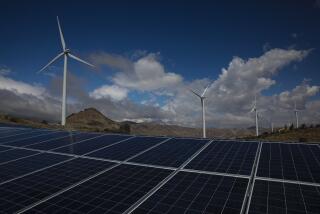Editorial: Can California meet its ambitious greenhouse gas goals?
When President Obama announced his controversial and ambitious Clean Power Plan to reduce greenhouse gas emissions from power plants, Californians gave a collective yawn. The president’s goal of generating 28% of the nation’s electricity from renewable resources by 2030 paled next to California’s push, which began nearly a decade ago, to fuel 33% of its electrical needs with solar, wind and other renewables by 2020.
The state’s commitment to a serious climate change policy began in 2006 with the passage of AB 32, the landmark Global Warming Solutions Act. That law required the Air Resources Board to formulate a plan for 2020 that would bring greenhouse gas emissions down to where they had been in 1990. And now that California is on track to meet that goal, it’s time for the next, more ambitious step: SB 32.
The bill would ratchet up the effort considerably, calling for the state to reduce greenhouse emissions by 2030 to 40% below where they were in 1990.
That’s not a figure to shrug or yawn about; it’s considerably more aggressive than the AB 32 goal, which entails cutting emissions by 15% of what they would have been under a business-as-usual scenario. Nonetheless, the bill should pass. The state has already laid the groundwork, and besides, there’s no alternative. Climate change is palpably afflicting the planet — for instance, it has worsened the California drought of the last four years, according to a study released last week — and this is just the start. The state obviously can’t fight climate change on its own, but it plays an important leadership role.
A companion bill of sorts, SB 350, also has useful elements, though it would be improved if it offered greater flexibility. The bill directs state agencies to do three things by 2030: pump up the state’s renewables portfolio to 50%, and halve both the amount of energy used by buildings statewide and the state’s use of petroleum for vehicles.
The state is off to a good start on renewable sources of electricity, and that can be expected to grow tremendously in the coming years, but the latter two goals might not be attainable within 15 years. Even if tough new fuel standards for vehicles are imposed, would enough older cars be replaced with electric, hybrid or substantially more gas-thrifty models to meet that extremely ambitious goal? Housing follows a much longer life-cycle than automobiles, and how much retrofitting could the state afford, even if it uses money from the state’s cap-and-trade fund, to bring its vast building stock into compliance?
The bill usefully directs state agencies, such as the Public Utilities Commission, to begin marshaling their financial and regulatory resources toward these reductions in fossil fuel use. But it would be better to leave specific goals to the ARB, the agency charged with the big-picture task of determining how best to reduce carbon emissions.
Follow the Opinion section on Twitter @latimesopinion and Facebook
More to Read
A cure for the common opinion
Get thought-provoking perspectives with our weekly newsletter.
You may occasionally receive promotional content from the Los Angeles Times.






